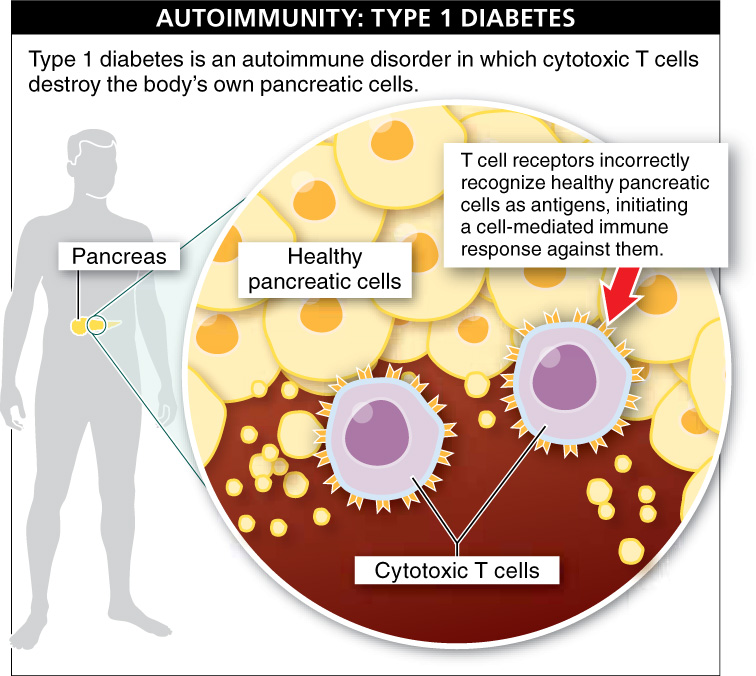

What happens when the immune system malfunctions? Genetic defects, environmental influences, and even viruses can trigger immune dysfunction. And in many cases, such as autoimmune diseases, a combination of causes is suspected, but not completely understood. Autoimmunity occurs when an individual’s immune system responds inappropriately to the individual’s own cells and tissues as if they were pathogens, mistaking “self” for “non-
Type 1 diabetes (sometimes called juvenile diabetes) is an example of an autoimmune disorder. It is diagnosed in more than 13,000 young people in the United States each year. Symptoms include high blood glucose levels, weight loss, unquenchable thirst, frequent urination, fatigue, and weakness. In this disease, cytotoxic T cells, complement proteins, and macrophages destroy the person’s own pancreatic cells. Without a normal pancreas, a person cannot make insulin (FIGURE 26-28). Without insulin, cells in need of glucose are not able to take it up from the blood, even though glucose is plentiful. In turn, the body breaks down muscle and fat tissues to provide cells with needed energy, and blood glucose levels remain high. The exact cause of this autoimmune reaction is not understood. Treatment for individuals with type 1 diabetes is insulin injections or implantation of an insulin pump, which directly monitors blood glucose levels and releases insulin as needed.
1069

In some disorders, including type 1 diabetes, the immune system destroys a single cell type or a single organ. In other disorders, the damage is spread throughout the body. When the insulation that surrounds nerve fibers of the brain and spinal cord is under immune attack, the resulting disorder is called multiple sclerosis (MS) (see Section 23-
Rheumatoid arthritis is another autoimmune disease that affects women more frequently than men, and it usually strikes between ages 40 and 60. (This form of arthritis is a far less common cause of joint inflammation than osteoarthritis, which is not an autoimmune disease.) The linings of joints are the targets of this immune attack—
TAKE-HOME MESSAGE 26.11
When lymphocytes bear receptors that inappropriately recognize structures of a person’s own body as foreign invaders, autoimmunity develops. Autoimmune responses can do significant damage to specific organs or to tissues throughout the body, depending on where the antigens are located.
Define autoimmunity, and then name one autoimmune disorder, describing how it affects the body.
Autoimmunity occurs when the immune system responds inappropriately to an individual's own cells and tissues as if they were pathogens, mistaking “self ” for “non-self.” Type 1 diabetes (sometimes called juvenile diabetes) is an example of an autoimmune disorder. In this disease, cytotoxic T cells, complement proteins, and macrophages destroy the person's own pancreatic cells. Without a normal pancreas, a person cannot make insulin. Without insulin, cells in need of glucose are not able to take it up from the blood, though glucose is plentiful. In turn, the body breaks down muscle and fat tissues to provide cells with needed energy, and blood glucose levels remain high. Symptoms include high blood glucose levels, weight loss, unquenchable thirst, frequent urination, fatigue, and weakness. Other autoimmune diseases include rheumatoid arthritis and multiple sclerosis. You may be able to think of other examples.